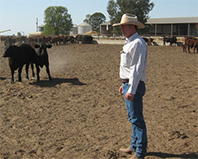Read the latest information on
Foot-and-mouth disease

Cloncurry stock and station Agent, Peter Dowling, encourages people to be aware of the cattle movement restrictions for Western Australia and the Northern Territory.
Stock and station agent, Peter Dowling, from Cloncurry in Queensland thought he had all the right checks and balances. In 2014, Peter purchased and transported a herd of stud bulls from Queensland and commercial cows from the Northern Territory to Western Australia on behalf of a client. However, upon arrival at the border to Western Australia, approximately 150 commercial cows were turned away because they were originally bred in Queensland and had not originated from a bovine Johne’s disease (BJD) tested free herd.
Whilst Peter’s experience happened a few years ago, he wanted to highlight that, despite the new national approach to JD in cattle – the BJD Framework – there are still strict requirements around JD when exporting cattle to Western Australia and the Northern Territory.
“When I organised the movement of cattle to WA in 2014, I ensured that all the animals met the requirements for importing cattle from the Northern Territory. However, it did not occur to me that 150 of the commercial cows would be rejected because they had been bred in Queensland and came from a herd that had not been tested for Johne’s disease. Thankfully, I was able to negotiate a sale of the rejected livestock to a property back in the Northern territory, but there were still significant associated labour and freight costs,” said Mr Dowling.
“I urge anyone looking to move cattle to the Northern Territory or Western Australia to recognise that both these jurisdictions still have a number of JD entry requirements, with requirements varying between the two,” Mr Dowling said.
The Livestock Biosecurity Network’s newest recruit Rachael O’Brien who is working closely with northern-Australian cattle producers echoed Mr Dowling’s comments.
“The new BJD Framework includes a number of key changes including the removal of BJD zoning for the eastern states, a move to a market driven approach where producers undertake practices dependent on market requirements and the ceasing of quarantining of properties found to be infected,” Ms O’Brien said.
“To ensure they keep a ‘BJD free’ status, Western Australia and the Northern Territory have opted to retain their existing livestock movement restrictions. To learn about the restrictions in place for the Northern Territory and Western Australia, visit their respective department websites,” Ms O’Brien said.
Cattle producers are also encouraged to visit the Farm Biosecurity website’s beef cattle page and dairy cattle page to learn how to implement a biosecurity plan which is a critical ingredient in helping meet the movement restrictions for Western Australia and the Northern Territory.